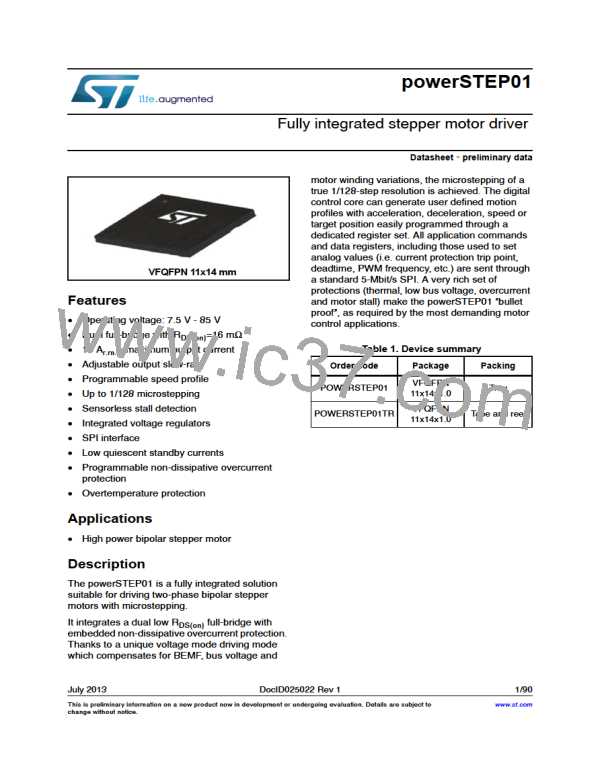Phase current control: voltage mode
powerSTEP01
8
Phase current control: voltage mode
When the voltage mode driving is selected (CM_VM bit in STEP_MODE register is set to 0),
the powerSTEP01 controls the phase current applying a sinusoidal voltage to motor
windings. Phase current amplitude is not directly controlled but depends on phase voltage
amplitude, load torque, motor electrical characteristics and rotation speed. Sinewave
amplitude is proportional to the motor supply voltage multiplied by a coefficient (KVAL). KVAL
ranges from 0 to 100% and the sinewave amplitude can be obtained through the following
formula:
Equation 1
VOUT = VS ⋅ KVAL
Different KVAL values can be programmed for acceleration, deceleration and constant speed
phases and when the motor is stopped (HOLD phase) through KVAL_ACC, KVAL_DEC,
KVAL_RUN and KVAL_HOLD registers (Section 11.1.10). KVAL value is calculated
according to the following formula:
Equation 2
KVAL = [(KVAL_X + BEMF_COMP) × VSCOMP × K_THERM] × microstep
where KVAL_X is the starting KVAL value programmed for the present motion phase
(KVAL_ACC, KVAL_DEC, KVAL_RUN or KVAL_HOLD), BEMF_COMP is the BEMF
compensation curve value, VSCOMP and K_THERM are the motor supply voltage and
winding resistance compensation factors and microstep is the current microstep value
(fraction of target peak current).
The powerSTEP01 offers various methods to guarantee a stable current value, allowing the
compensation of:
•
•
•
•
Low speed distortion (Section 8.3)
Back electromotive force (Section 8.4)
Motor supply voltage variation (Section 8.5)
Winding resistance variation (Section 8.6)
38/90
DocID025022 Rev 1

 STMICROELECTRONICS [ ST ]
STMICROELECTRONICS [ ST ]